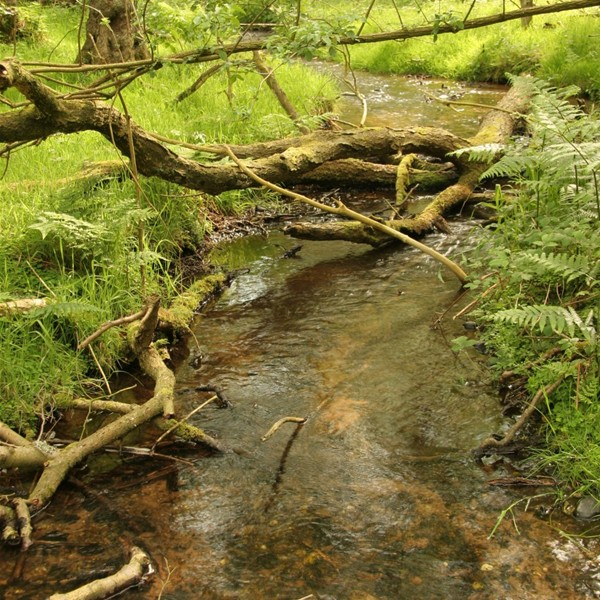Coarse woody debris in stream channels has multiple ecological and hydrologic benefits. Coarse woody debris consists of large sections of deadfall: tree stems or stumps that either fall into or are deliberately placed in streams. Coarse woody debris can be deployed with varying degrees of naturalness. At one extreme, coarse woody debris can be used to form coffer or placer dams which effectively limit water flow. At the other extreme, natural deadfall coarse woody debris is found when riparian trees are allowed to fall naturally into streams. Coarse woody debris will generally slow water flow velocity and can reduce the peak of flood hydrographs. In addition to its role in slowing streamflow and facilitating sediment accumulation, coarse woody debris can improve aquatic biodiversity by retaining food and providing additional habitat, such as refuges and spawning sites.

River with coarse woody debris
Source: http://www.sitatrust.org.uk/projects/can-we-save-the-native-crayfish
| Benefits | Level |
|---|---|
|
BP3 - Store river water
|
Low
|
|
BP4 - Slow river water
|
High
|
|
BP10 - Reduce erosion and/or sediment delivery
|
Low
|
|
BP12 - Create aquatic habitat
|
High
|
|
BP13 - Create riparian habitat
|
Medium
|
|
ES2 - Fish stocks and recruiting
|
High
|
|
ES4 - Biodiversity preservation
|
High
|
|
ES7 - Flood risk reduction
|
Medium
|
|
ES8 - Erosion/sediment control
|
Low
|
|
ES10 - Recreational opportunities
|
Medium
|
|
PO1 - Improving status of biology quality elements
|
Medium
|
|
PO9 - Take adequate and co-ordinated measures to reduce flood risks
|
Medium
|
|
PO10 - Protection of important habitats
|
Medium
|
|
PO11 - Better protection for ecosystems and more use of Green Infrastructure
|
Medium
|
|
PO13 - Better management of fish stocks
|
Medium
|
|
PO14 - Prevention of biodiversity loss
|
Medium
|
